
Learn how to avoid shortening your frying pan’s lifespan

Learn how to avoid shortening your frying pan’s lifespan
You’ve finally bought a fluororesin-coated frying pan. Naturally, you want to keep it “non-stick” for as long as possible, right?
The reason food doesn’t stick easily is thanks to the fluororesin coating on the inner surface of the pan.
However, the lifespan of this coating greatly depends on how you use the pan in your daily cooking.
In this article, we’ll introduce some “things you should avoid” that can shorten your frying pan’s lifespan, as well as tips on when it might be time to replace it.
By learning about the uses to avoid, we hope you’ll be able to enjoy your frying pan for a longer time and keep it in great condition.
Uses to Avoid That Can Shorten Your Frying Pan’s Lifespan
The following uses can damage the fluororesin coating on your frying pan and shorten its lifespan.
To keep the non-stick surface in good condition for as long as possible, please pay attention to the points below.
Cooking Over High Heat
Fluororesin coating is sensitive to extremely high temperatures and begins to deteriorate when exposed to temperatures above 260°C (500°F).
Under normal cooking conditions, the temperature rarely reaches that high. However, using high heat can cause certain areas of the pan to become excessively hot, which may lead to coating deterioration.
Furthermore, if the flame extends beyond the bottom of the pan, it can reach the handle, causing burns or damage.
When cooking, keep the heat at medium or lower so that the flame does not go beyond the bottom of the pan.
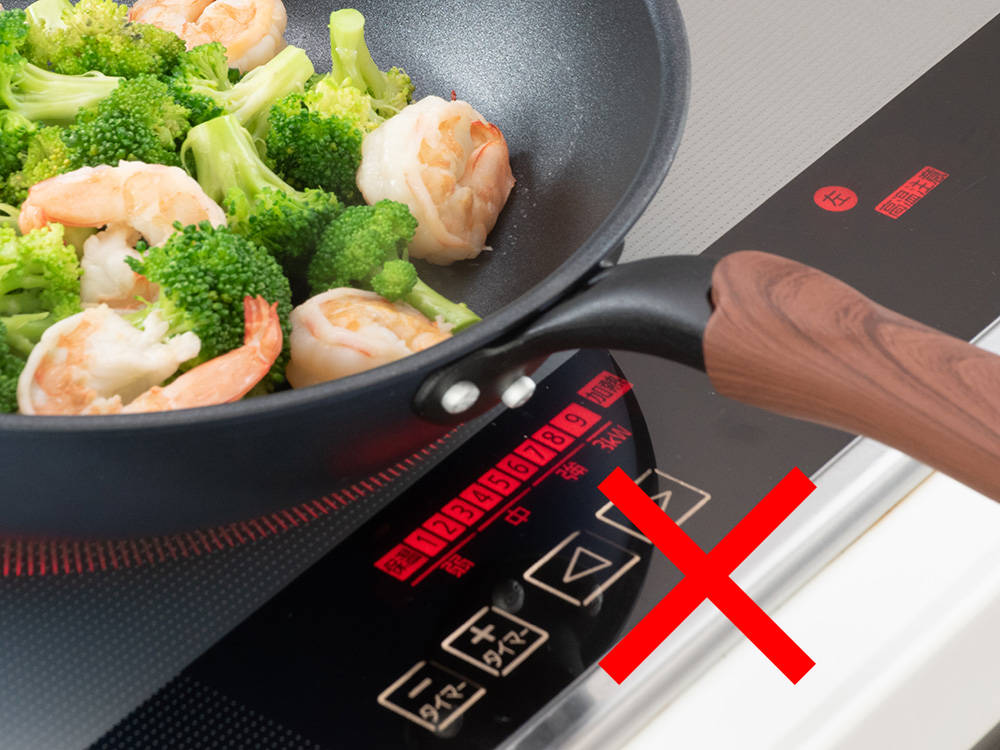
Dry Heating the Pan
Heating the pan without any ingredients, known as dry heating, can cause the surface temperature to rise rapidly in a short time and severely damage the fluororesin coating.
It also poses a fire hazard, so please never heat the pan when it’s empty.
In addition, there’s no need to preheat the pan for a long time before cooking — preheating is sufficient when a drop of water sizzles and bounces on the surface.
Furthermore, putting only a small amount of food in a frying pan that’s too large can cause the uncovered areas to overheat, effectively creating a dry-heating condition that damages the coating.
Choose a frying pan that matches the amount of food you’re cooking.
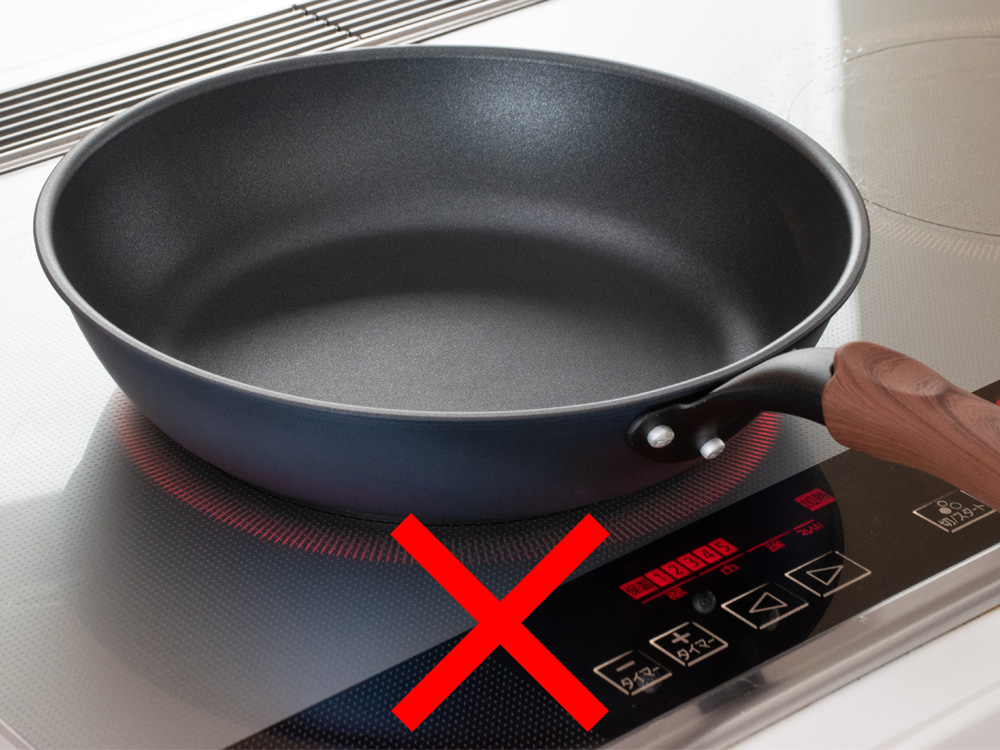
Scrubbing with Metal Utensils, Steel Wool, or Hard Sponges
Scrubbing the pan with metal tools while cooking can scratch the fluororesin coating.
Similarly, using steel wool or hard sponges when cleaning should be avoided.
Once the surface is scratched, the coating can start to peel off more easily.
Use utensils made of soft materials such as wood, bamboo, or silicone for cooking, and a soft sponge for washing.
Even for frying pans labeled as “metal utensil safe,” using utensils made of softer materials will help the fluororesin coating last longer.

Rapid Cooling
When heated during cooking, the fluororesin coating becomes soft and slightly expands.
If you suddenly cool it with cold water, the coating can contract unevenly, causing the surface to become rough and reducing its non-stick performance.
When washing the frying pan after cooking, let it cool down completely before rinsing it with water.
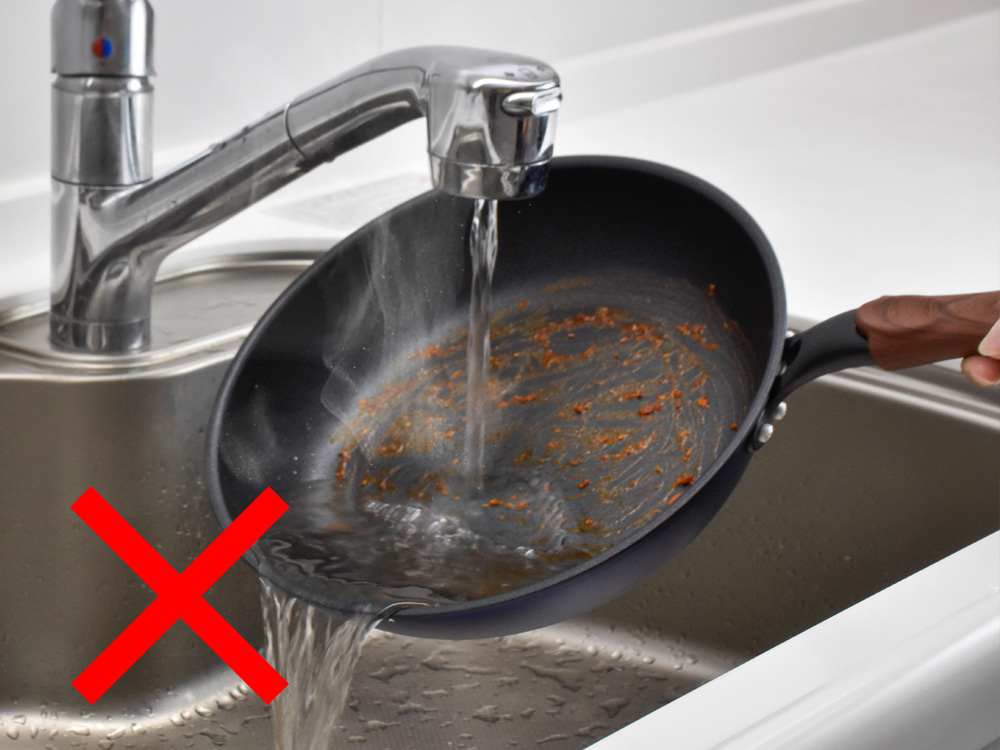
Leaving Food in the Pan for a Long Time
Fluororesin coatings have tiny, microscopic pores that aren’t visible to the eye.
If cooked food is left in the frying pan for an extended period, salt and other seasonings can seep into these pores.
Over time, the absorbed salt can penetrate between the fluororesin layer and the metal base, gradually causing the metal to corrode and the coating to peel off.
If you need to store the food, be sure to transfer it to a different container.
Even for temporary storage, try not to leave it in the pan for more than about one night.
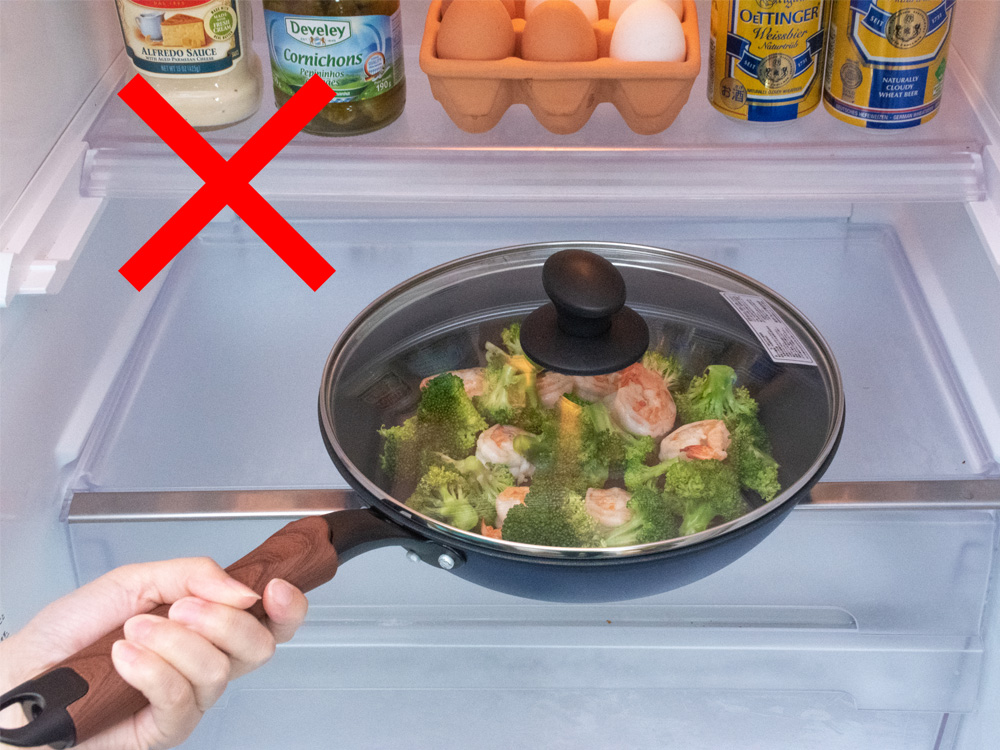
Can Salt Restore the Non-Stick Surface?
On social media, you may come across posts claiming that rubbing salt onto a fluororesin-coated frying pan that has lost its non-stick quality can make it non-stick again.
However, as a manufacturer, we do not recommend this method.
It’s true that when salt is heated and rubbed on the frying pan, the moisture evaporates and the salt acts like an abrasive.
This can temporarily smooth the surface, making it seem less sticky.
However, at the same time, it creates countless tiny scratches on the fluororesin coating and scrapes away the coating layer itself.
As a result, this can cause the coating to peel off and ultimately shorten the lifespan of the frying pan.
This method may work as a last resort when the pan is truly at the end of its life and you just want to use it a little longer.
However, we do not recommend trying it on a new pan or one that still performs well in normal use.
When It’s Time to Replace Your Frying Pan
If your fluororesin-coated frying pan shows any of the following signs, it’s time to consider replacing it.
Peeling of the Inner Fluororesin Coating
If the inner fluororesin coating has peeled off and the base material is visible, it’s a sign that it’s time to replace the pan.
Please note that Wahei Freiz frying pans are made without PFAS.
Even if a small amount were accidentally ingested, it would not be absorbed by the body and would be completely excreted, so there is no need to worry.

Discoloration of the Inner Fluororesin Coating
If the fluororesin coating has become discolored due to heat and food has started to stick more easily, it’s also a sign that it’s time to replace the pan.
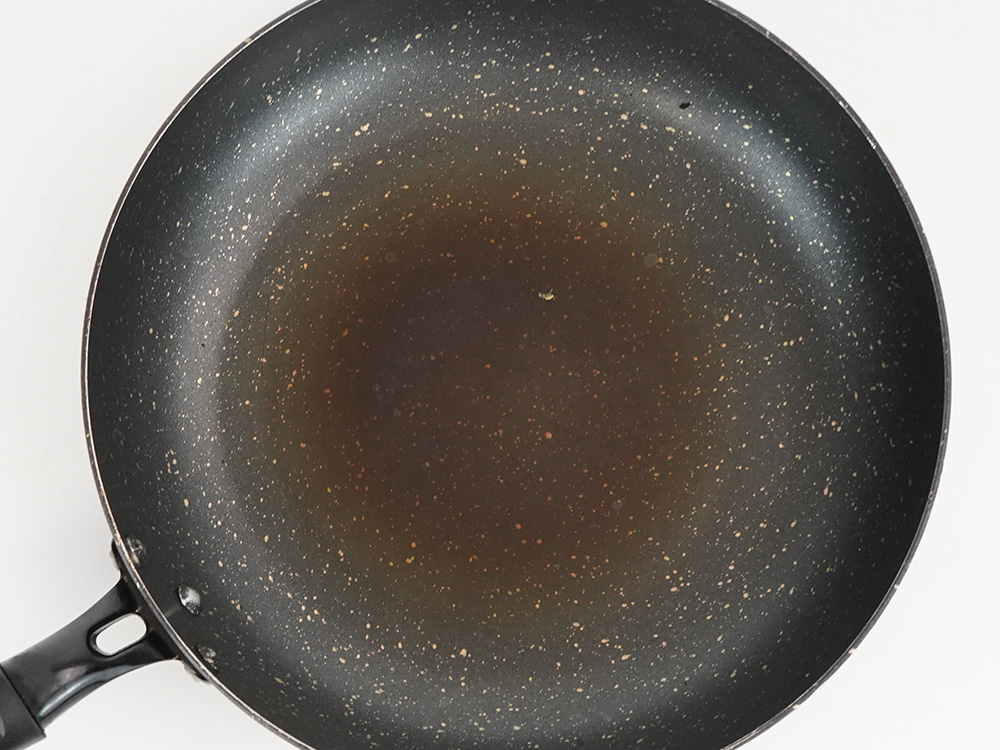
Deformation of the Pan Body
Continuing to use a frying pan that has become deformed due to heat or other factors can be dangerous.
In particular, if the bottom has become uneven or the pan wobbles when placed on the stove, it may lose stability during cooking and could lead to accidents.
Stop using the pan immediately if you notice these conditions.
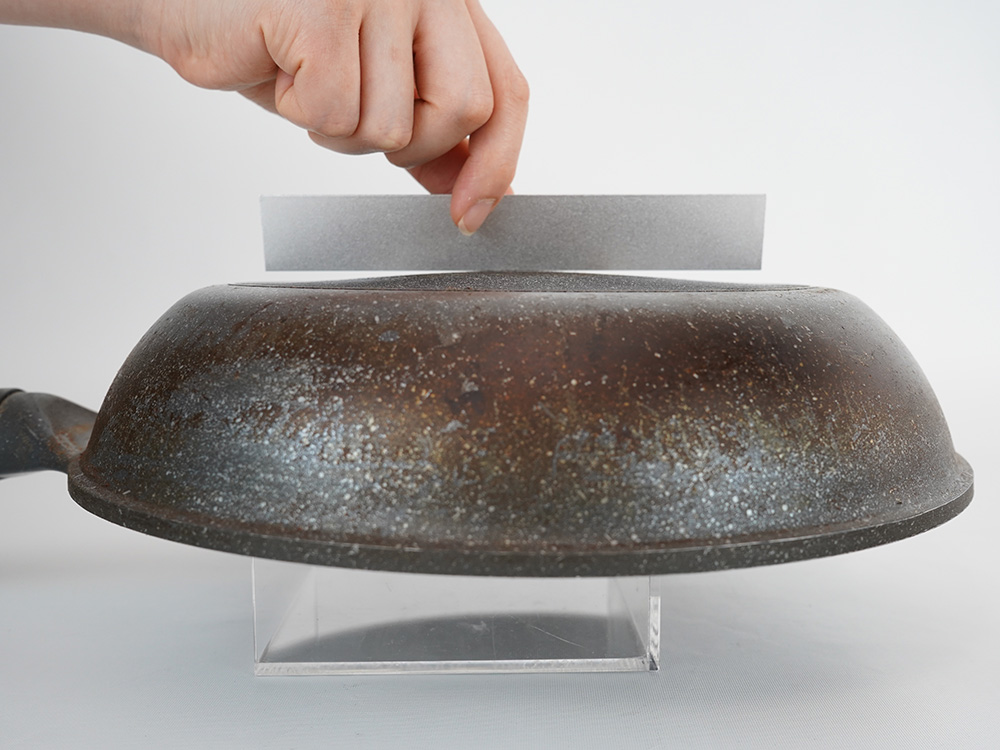
Damage to the Handle
A frying pan with a loose or cracked handle is extremely dangerous. If you notice any damage, stop using it immediately.
How to Tell When It’s Time to Replace Your Pan
Because fluororesin coatings don’t show significant visible changes until they have deteriorated considerably, it can be difficult to judge when to replace the pan based on appearance alone.
To determine whether it’s time to replace your pan, try cooking yakisoba.
If you notice that the noodles start to stick to the surface during cooking, it’s a sign that the fluororesin coating is nearing the end of its lifespan — and it may be time to consider getting a new pan.
Introduction to the Frying Pan recommended by Wahei Freiz.
Among Wahei Freiz frying pans, here are some recommended models with high-quality fluororesin coatings.
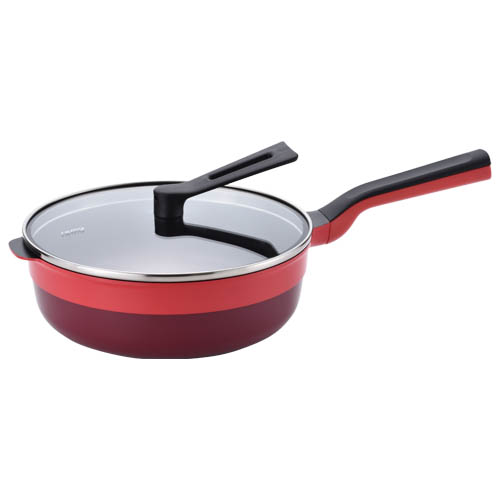
remy pan plus
The remy pan plus retains the all-in-one functionality of the original remi pan, which can stir-fry, grill, boil, steam, deep-fry, and cook rice, while adding convenience and enhanced cooking performance. This next-generation frying pan was created to pursue the deliciousness and enjoyment of cooking.
